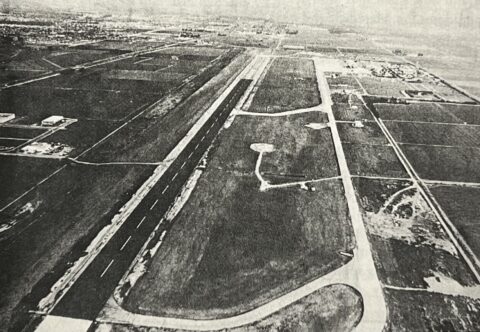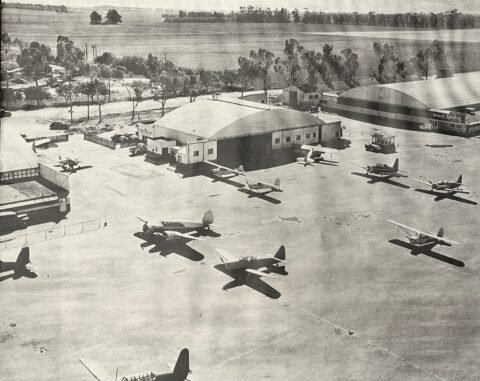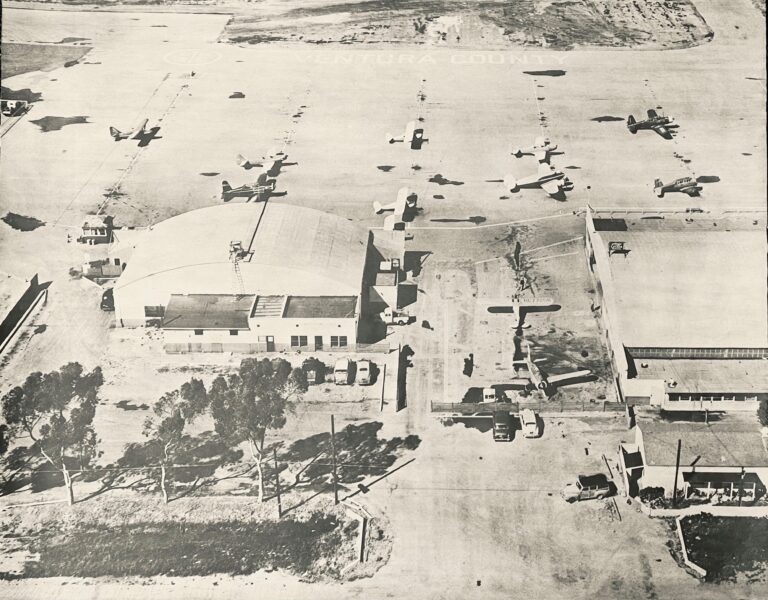Airport History
Click here to view the Did You Know? Airport History Informational Flyer
Camarillo Airport History

The genesis of the Camarillo Airport can be traced to 1942 when the California State Highway Department constructed an auxiliary landing field with a 5,000 foot runway. In the 1951 response to the emerging Cold War, and to potential need for bolstered coastal air defense, the Army Corps of Engineers extended the runway to 8,000 feet. Additional construction on the then-named Oxnard Air Force Base neared completion in 1957 and the base was equipped with the Northrop F-89 “Scorpion” aircraft as part of the Los Angeles area Air Defense Command. By 1958 the new Air Force base boasted four alert hangars, concrete ramps, and a 9,000 foot runway. The runway was complete with an ILS, VOR, and safety overruns. It was an entire community with administration buildings, enlisted housing, recreational facilities, a theater, and even a gas station. In 1960, the supersonic McDonnell Douglas F-101B “Voodoo” interceptor aircraft, equipped with “Genie” tactical nuclear missiles, arrived on the Oxnard Plain and served there for almost a decade.
For nearly eighteen years dedicated Air Force personnel provided air defense protection for the Southern California area. In December 1969 the Department of Defense deactivated Oxnard Air Force Base and transferred its aircraft and personnel to other facilities. The land became surplus property.
The County of Ventura pursued acquisition of the airfield portion of the facility for air carrier service and general aviation while other governmental and educational organizations were attracted to the 60 buildings. For seven years the battle for the surplus property continued, with opposition the heaviest from the neighboring city of Camarillo. City representatives strongly objected to any kind of airport replacing the now abandoned Air Force base. Finally, an agreement was reached which provided for an airport limited to general aviation and a 6,000 foot runway.
In October 1976 the General Services Agency approved the county’s application for 650 acres of land, including some buildings. Other agencies expressed an interest in the remaining 100 acres. The property was conveyed to the county by quitclaim deed which outlined specific use restrictions. With the ownership defined, the County of Ventura assigned management of the airport to the County Property Administration Agency. In 1985 airport management was successful in separating the two county-owned airports from the Property Administration Agency, thus creating the County of Ventura Department of Airports.
Camarillo Airport has progressed from a sleepy, tower-less facility to a bustling reliever airport with an FAA air traffic control tower and over 150,000 annual takeoffs and landings. Today the airport boasts a diverse collection of over 560 production, home built, and WWII aircraft with active chapters of the Experimental Aircraft Association and the Commemorative Air Force. With increasing congestion in the Los Angeles basin, pilots and aircraft owners find Camarillo’s location, size, and weather to be significant factors in using the airport.
The draw of recreational and corporate aircraft paints an encouraging picture for the future of Camarillo Airport. As the region grows, Camarillo Airport will be ready to play its role in serving the needs of general aviation in Ventura County.
Oxnard Airport History

The Oxnard Airport was opened in 1934 by the County of Ventura and consisted of a 3,500 foot dirt runway. The first fixed base operator on the field was Joe Plosser. He owned only two aircraft, but had no housing for them. During the thirties Howard Hughes erected a tent on the airport to shelter his H-1 racer, which he tested from the Oxnard Airport.
The County of Ventura paved the runway in 1938 and a large hangar (now known as Hangar #2) was built by the Works Progress Administration. In 1939 James “Elmo: McLean opened the Oxnard Flying School with two aircraft, a 40hp J-3 Cub and a Kinner two-seater. The U.S. Army Air Corp moved its civilian training program onto the airport in 1940 to establish a primary training base called Mira Loma Flight Academy. Housing was built across the street for the cadets and instructors.
In December 1941 war was declared, as a result all civilian flying was curtailed within 200 miles of the coastline. As a result, the Oxnard Flying School, moved to Boulder City, Nevada. The Army Air Corp operated the airport until 1944 when it was reassigned to the Navy until the Naval Air Station at Point Mugu could be completed. The Navy moved to NAS Point Mugu in 1945 and the Oxnard Flying School returned to the airport. The County of Ventura officially regained control of the airport from the federal government in 1948 by receiving a final quitclaim deed. The State of California issued the airport an operating permit in 1949.
The first scheduled airline flights began in 1946 by Southwest Airlines and later Pacific Airlines, flying Douglas DC-3’s and Fokker F-27’s respectively. Pacific Airlines was replaced by Airwest Airlines in 1967, which was later purchased bu the Hughes Corporation, becoming Hughes Airwest. The current terminal building opened in 1971 and has been served by commuter airlines such as Cable, Golden West, Wings West, Mesa and other small air carriers.
The Federal Aviation Administration built and staffed the air traffic control tower in 1960 and in 1963 Oxnard’s single runway (7-25) was extended from 4,750 feet to its present length of 5,953 feet. Between 1974 and 1976 the runway was upgraded with an ILS and approach lighting. In July 1992 it was completely rebuilt and again in 2021 after 29 years in service.
In 2010, the County and the FAA partnered on a project to lengthen the landing distance at the airport from 4,610 feet to 5,953 feet where it is today. This enhancement enables the airport to accommodate modern regional jets rather than just turbo prop aircraft for airline service needs.
Today, Oxnard Airport is without air service as it is one of many small community airports that have needed to adapt to changes in airline business models and shortages in regional aircraft and pilots. The County continues to look closely for airlines that could be a good fit and provide convenient travel directly to popular destinations. Two rental car companies still operate out of the airport terminal.
The airport is still an important element of the national transportation system with multiple thriving aviation businesses and over 125 based aircraft. The Oxnard Airport has been Ventura County asset for over 80 years.

